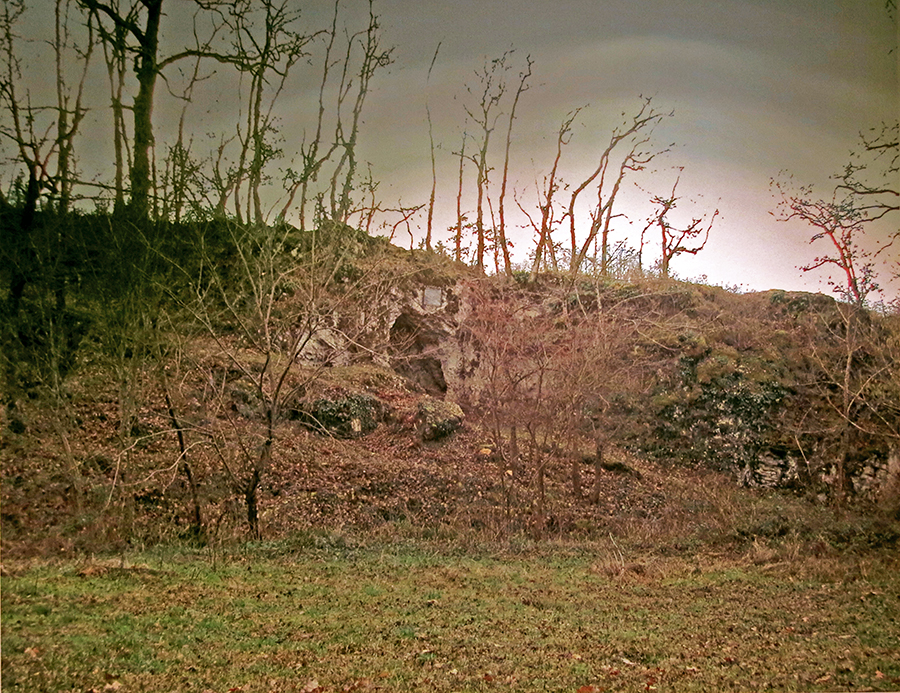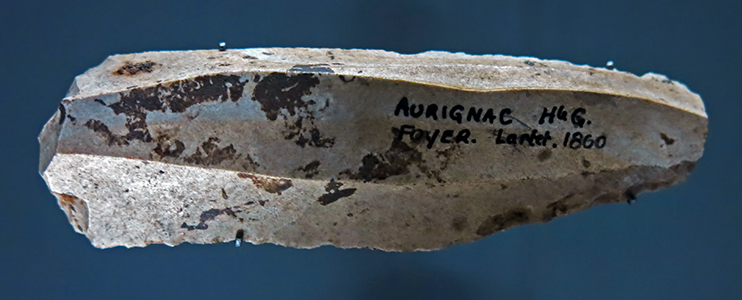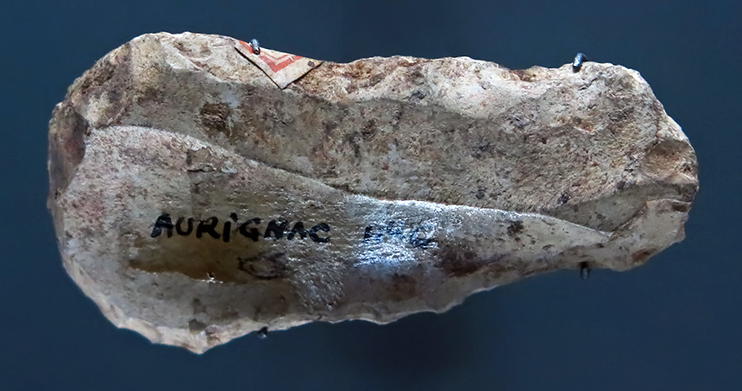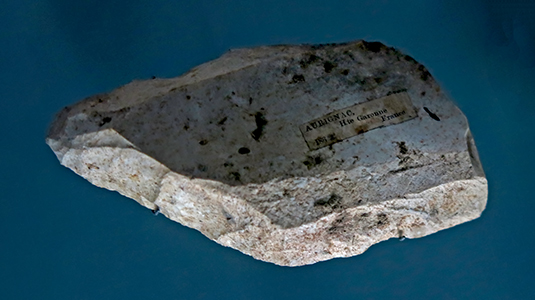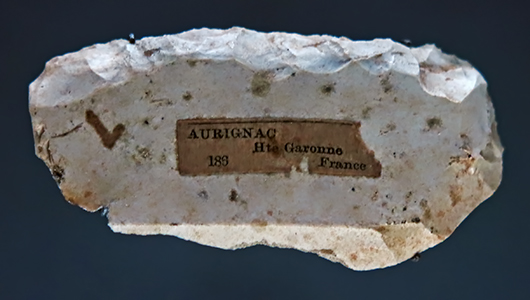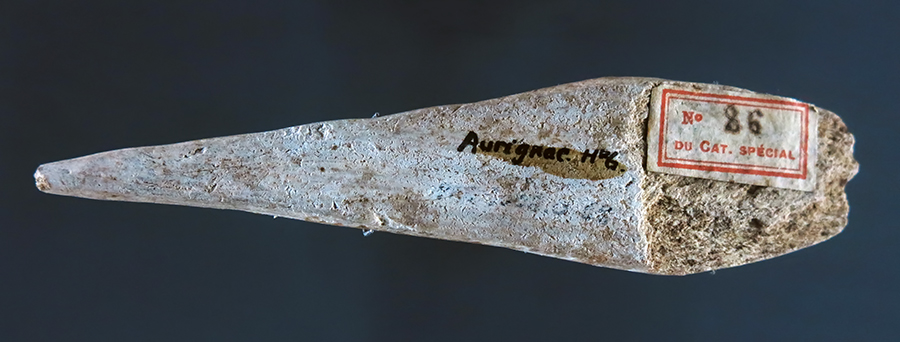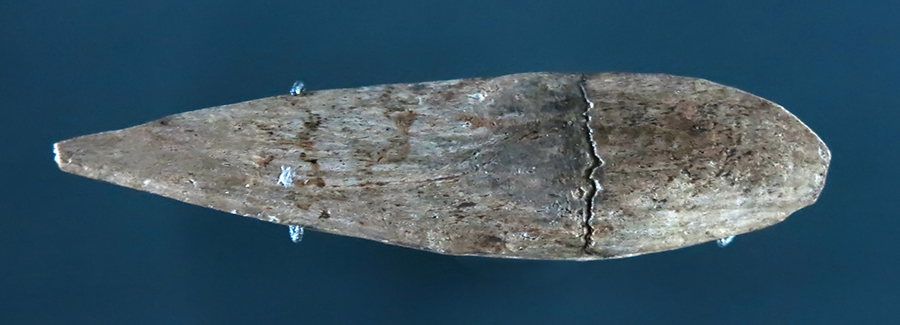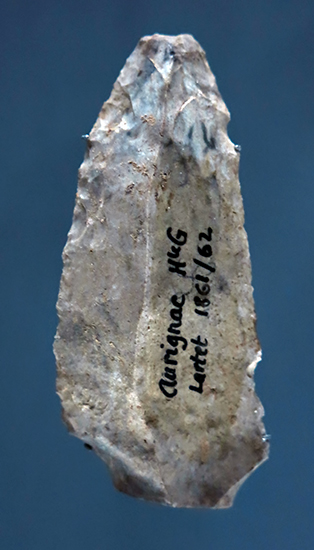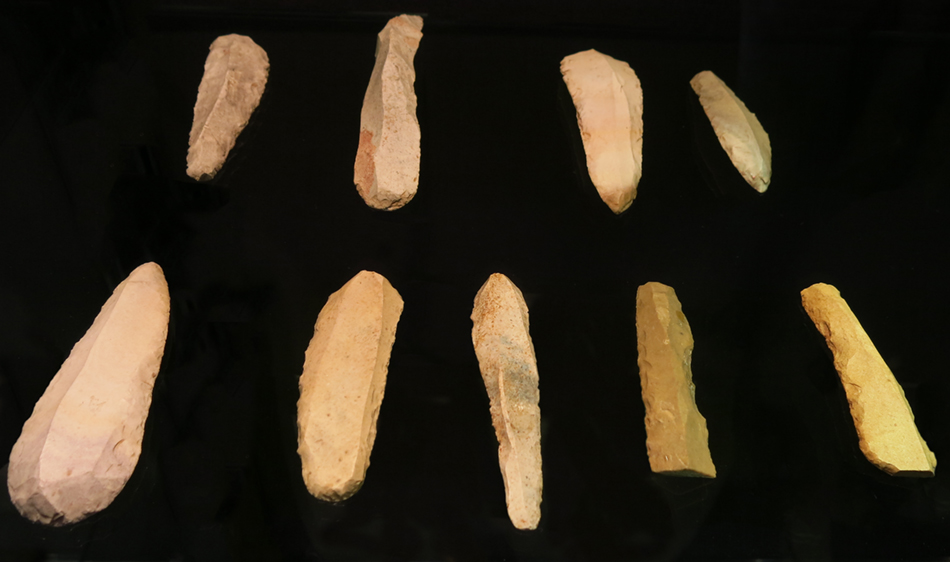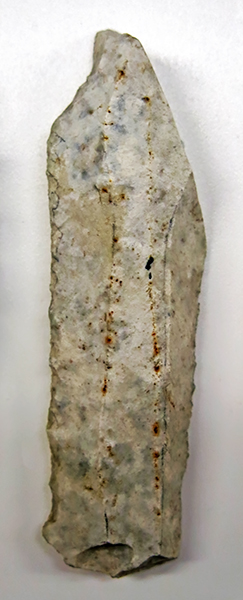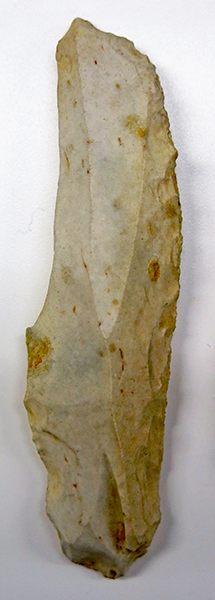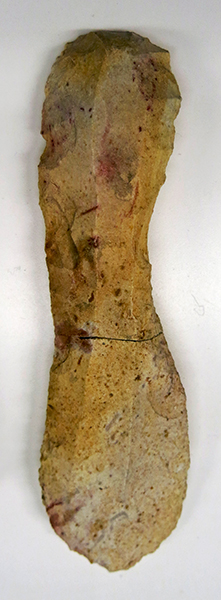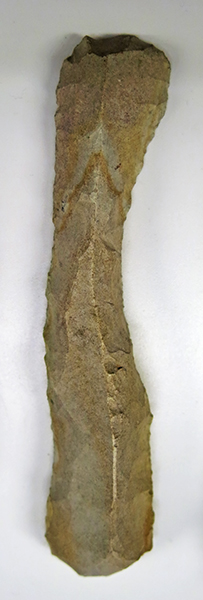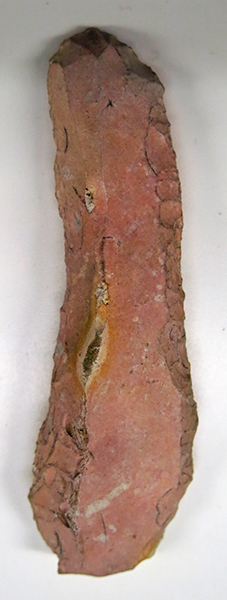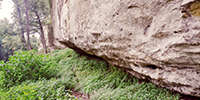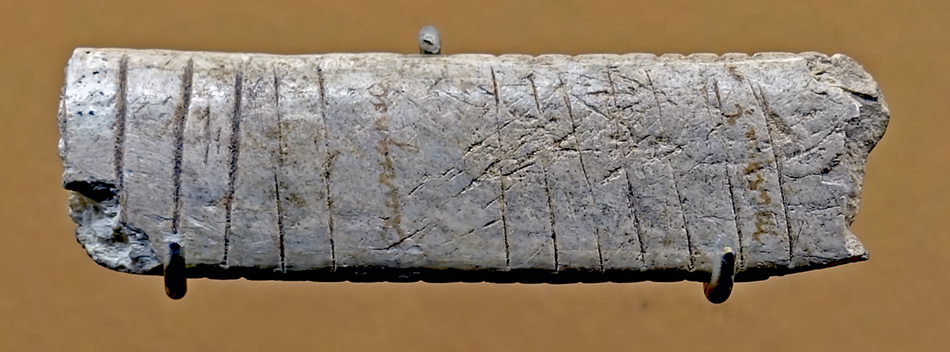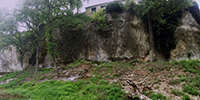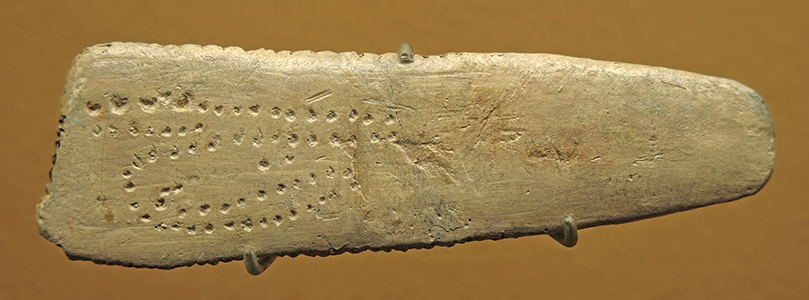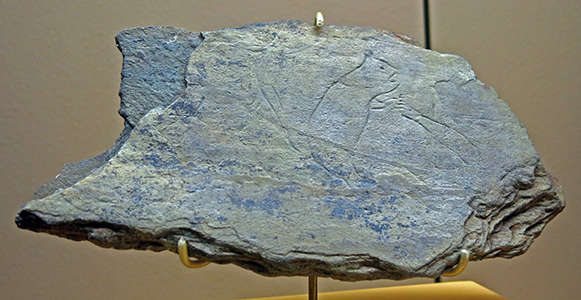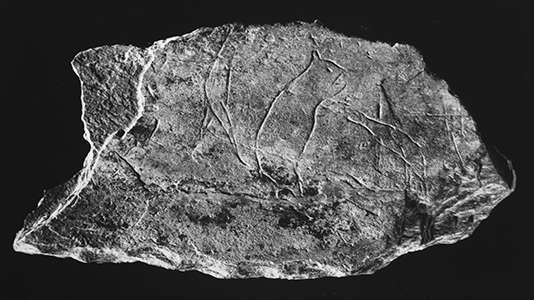Back to Don's Maps
 Back to Archaeological Sites
Back to Archaeological Sites
 Back to the review of hominins
Back to the review of hominins
La Grotte d'Aurignac and the Aurignacian
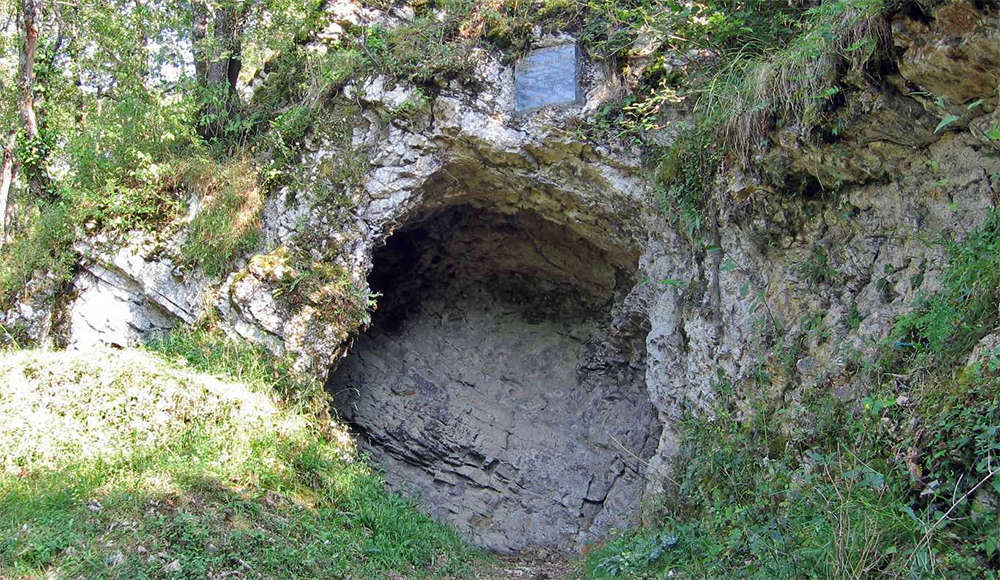
La Grotte d'Aurignac
Photo: Totor-22
Permission: GNU Free Documentation License
La Grotte d'Aurignac is a cave located in the commune of Aurignac , in Haute-Garonne (Midi-Pyrenees , France. Occupied during the Upper Palaeolithic, it gave its name to the Aurignacian, a prehistoric culture of the beginning of that period. The cave is named after the town in which it is located, Aurignac. The cave is now reduced to a small rock-shelter. It is located at the northern end of the town of Aurignac, 1.6 km from the village. The cave was discovered in 1852 by Jean-Baptiste Bonnemaison and studied from 1860 by Édouard Lartet. The cave is very rich archaeologically.
Text above translated and adapted from the French Wikipedia.
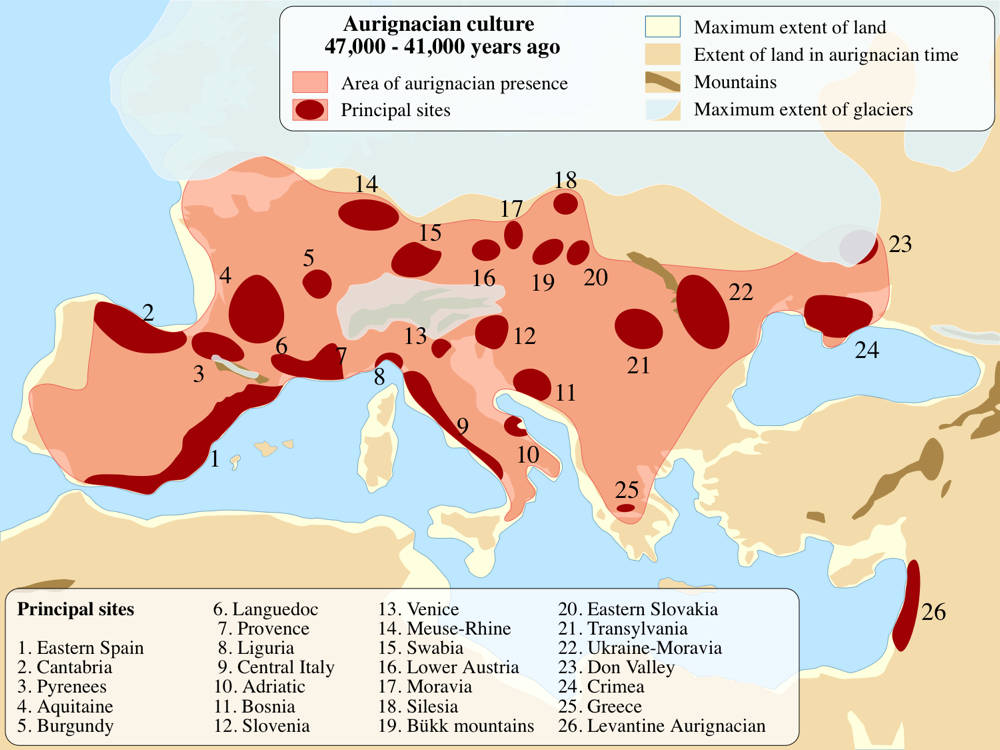
Map of Aurignacian culture.
Photo: Hughcharlesparker
Permission: CC-BY-SA-3.0
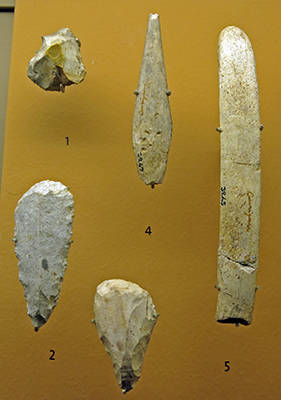
Aurignacian of la grotte d'Aurignac, Haute-Garonne
1: Grattoir caréné, keeled scraper.
2 and 3: Grattoir - these are convergent grattoirs, with two scraping surfaces meeting at an angle forming an isosceles triangle.
4: Sagaie à base fendue, spear point with split base.
5: Lissoir, polisher for working hides.
Photo: Don Hitchcock 2014
Source: Originals, Musée d'Archeologie Nationale et Domaine, St-Germain-en-Laye
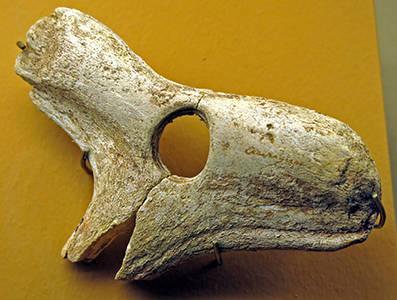
Aurignacian of la grotte d'Aurignac, Haute-Garonne
Baton percé, spear straightener.
Photo: Don Hitchcock 2014
Source: Original, Musée d'Archeologie Nationale et Domaine, St-Germain-en-Laye
La grotte d'Aurignac, Haute-Garonne
Photo: © Nathalie Rouqueyrol, Musee d'Aurignac (Haute Garonne)
Source: Musée d’art et d’archéologie du Périgord, Périgueux
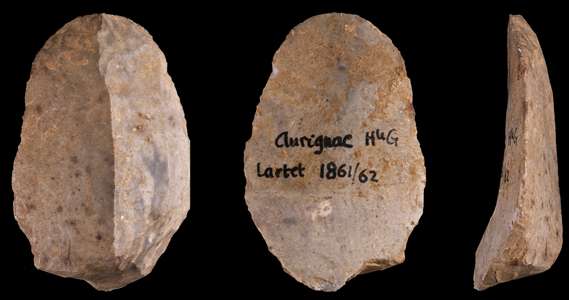
Aurignacian of la grotte d'Aurignac, Haute-Garonne
Aurignacian scraper on a blade, from the type site, Aurignac Cave in Southern France.
Date: between 37 000 and 28 000 BP
Medium: Flint
Current location: Muséum de Toulouse, France
Object history: Findspot: Aurignac cave, Haute-Garonne, France. Former collection of Édouard Lartet, 1861
Photo: Didier Descouens
Permission: Creative Commons Attribution-Share Alike 3.0 Unported license.
Aurignacian of la grotte d'Aurignac, Haute-Garonne
Aurignacian grattoirs (end scrapers) on blades, from the type site, Aurignac Cave in Southern France.
Date: between 37 000 and 28 000 BP
Medium: Flint
Current location: Muséum de Toulouse, France
Object history: Findspot: Aurignac cave, Haute-Garonne, France. Former collection of Édouard and Louis Lartet, 1860
( Louis Lartet was Édouard Lartet's son, and at first a student of his. Louis later discovered the Cro-Magnon 1 man, one of the first fossil hominins to be recognised as a modern human, and went on to become a professor of Geology at the University of Toulouse - Don )
Photo: Don Hitchcock 2015
Source: Original, Muséum de Toulouse, France
Additional text: Wikipedia
Aurignacian of la grotte d'Aurignac, Haute-Garonne
Aurignacian grattoir à épaulement, shouldered grattoir, from the type site, Aurignac Cave in Southern France.
Date: between 37 000 and 28 000 BP
Medium: Flint
Current location: Muséum de Toulouse, France
Object history: Findspot: Aurignac cave, Haute-Garonne, France. Former collection of Édouard and Louis Lartet, 1860
( I find it difficult to distinguish shouldered grattoirs (grattoirs à épaulement) from nosed scrapers (grattoirs à museau) - Don )
Photo: Don Hitchcock 2015
Source: Original, Muséum de Toulouse, France
Aurignacian of la grotte d'Aurignac, Haute-Garonne
Pièce esquillée, literally 'stepped piece', a stone artefact, often wedge-shaped, with evidence of bipolar battering and reduction. These may have served as wedges for the splitting of bone or antler.
From the type site, Aurignac Cave in Southern France.
Date: between 37 000 and 28 000 BP
Medium: Flint
Current location: Muséum de Toulouse, France
Object history: Findspot: Aurignac cave, Haute-Garonne, France. Former collection of Édouard Lartet.
Photo: Don Hitchcock 2015
Source: Original, Muséum de Toulouse, France
Additional text: https://www.umanitoba.ca/faculties/arts/anthropology/manarchnet/appendices/glossary.html
Aurignacian of la grotte d'Aurignac, Haute-Garonne
Lissoirs, or smoothers, are shaped from deer ribs and have a polished tip that, when pushed against a hide, creates softer, burnished and more water resistant leather. The bone tool is still used today by leather workers.
From the type site, Aurignac Cave in Southern France.
Date: between 37 000 and 28 000 BP
Medium: bone, usually a rib
Current location: Muséum de Toulouse, France
Object history: Findspot: Aurignac cave, Haute-Garonne, France. Former collection of Édouard and Louis Lartet.
Photo: Don Hitchcock 2015
Source: Original, Muséum de Toulouse, France
Additional text: https://www.mpg.de/7494657/neandertals_leather_tools
Aurignacian of la grotte d'Aurignac, Haute-Garonne
Sagaies à base fendue, spear points with split bases used to attach them to the spear or dart shaft.
Date: between 37 000 and 28 000 BP
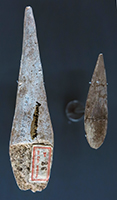
( Note the relative sizes of these two spear points - Don )
Current location: Muséum de Toulouse, France
Object history: Findspot: Aurignac cave, Haute-Garonne, France. Former collection of Édouard and Louis Lartet.
Photo: Don Hitchcock 2015
Source: Original, Muséum de Toulouse, France
Aurignacian of la grotte d'Aurignac, Haute-Garonne
Retouched blades.
Date: between 37 000 and 28 000 BP
( Note the pencilled L for Lartet on the right hand blade - Don )
Current location: Muséum de Toulouse, France
Object history: Findspot: Aurignac cave, Haute-Garonne, France. Former collection of Édouard and Louis Lartet.
Photo: Don Hitchcock 2015
Source: Original, Muséum de Toulouse, France
Blades from la grotte d'Aurignac, retouched to form grattoirs, end scrapers.
The Aurignacian was the first Upper Palaeolithic culture, 36 000 - 28 000 BP.
The Aurignacian culture occupied vast regions of Europe (amongst other places) during intensely cold climates and brief temperate periods. They invented technical skills, particularly in flint knapping as well as in the use of bones and antlers.
They were the first artists to express themselves almost solely with painting or engraving animals, cupules and vulvas, in stone and wood.
Photo: Don Hitchcock 2014
Source and text: Original, Musée d’art et d’archéologie du Périgord, Périgueux
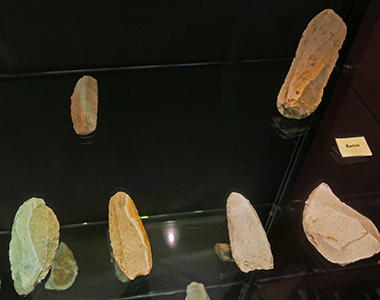
Scrapers from la grotte d'Aurignac.
Photo: Don Hitchcock 2014
Source: Original, Musée d’art et d’archéologie du Périgord, Périgueux
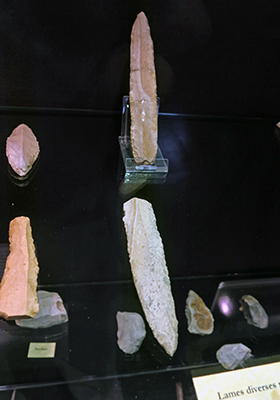
Various retouched blades from la grotte d'Aurignac.
Photo: Don Hitchcock 2014
Source: Original, Musée d’art et d’archéologie du Périgord, Périgueux

Percuteur, a hammer stone for knapping flint, from la grotte d'Aurignac.
Photo: Don Hitchcock 2014
Source: Original, Musée d’art et d’archéologie du Périgord, Périgueux

Burins from la grotte d'Aurignac.
Photo: Don Hitchcock 2014
Source: Original, Musée d’art et d’archéologie du Périgord, Périgueux
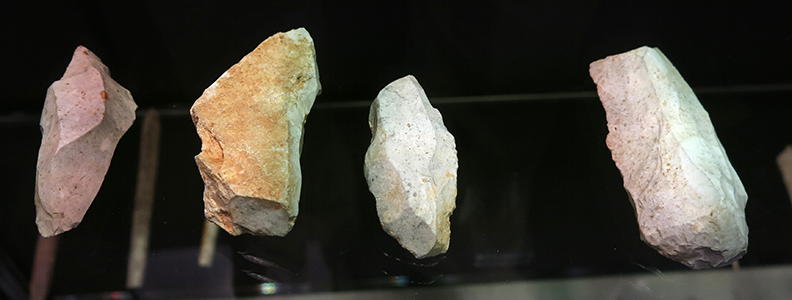
( These were labelled Burins busqués, or beaked burins. The tool on the right has a grattoir, an end scraper, on the closest end to the camera - Don )
Photo: Don Hitchcock 2014
Source: Original, Musée d’art et d’archéologie du Périgord, Périgueux
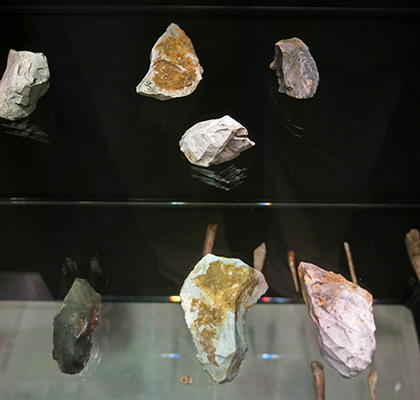
Burins from La Grotte d'Aurignac.
Photo: Don Hitchcock 2014
Source: Original, Musée d’art et d’archéologie du Périgord, Périgueux
Aurignacian burins, Grotte de Jolias, Prignac-et-Marcamps (33) and Laussel Marquay (24)
Flint, Inv. No. 60.913.8 and 61.3.85
Photo: Don Hitchcock 2015
Source: Original, Musée d'Aquitaine à Bordeaux
Lames Aurignaciennes, Aurignacian blades, Grotte de Jolias, Prignac-et-Marcamps (33) and Laussel Marquay (24)
( These blades have been knapped into double ended grattoirs, scrapers, with a distinct waist to make them fit the hand - Don )
These three tools are labelled as being Aurignacian blades, and coming from Grotte de Jolias, Prignac-et-Marcamps and Laussel, Marquay.
Judging from the catalog numbers, it is possible that the left hand tool is from Grotte de Jolias, and the other two are from Laussel.
They are large thick Aurignacian blades, retouched bilaterally and of the type known as waisted blades, or in French, 'strangled' blades, a very appropriate term.
Flint, Inv. No. 60.913.3, 61.3.80, 61.3.91
Photo: Don Hitchcock 2015
Source: Original, Musée d'Aquitaine à Bordeaux

Poinçon, awl, Laussel, Marquay (24)
Reindeer antler, Inv. No. 61.3.133
Photo: Don Hitchcock 2015
Source: Original, Musée d'Aquitaine à Bordeaux
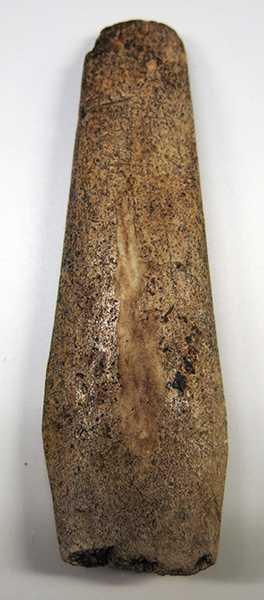
Ciseau à biseau simple, single bevel chisel, Laussel, Marquay (24)
( This bone chisel may have been used for splitting antler, perhaps after first using a burin to engrave a channel which could control the path of the split - Don )
Reindeer antler, Inv. No. 61.3.137
Photo: Don Hitchcock 2015
Source: Original, Musée d'Aquitaine à Bordeaux

Spear point with a split base, Laussel, Marquay (24)
( The split base spear point is emblematic of the Aurignacian, and is first known from this period - Don )
Reindeer antler, Inv. No. 61.3.89
Photo: Don Hitchcock 2015
Source: Original, Musée d'Aquitaine à Bordeaux
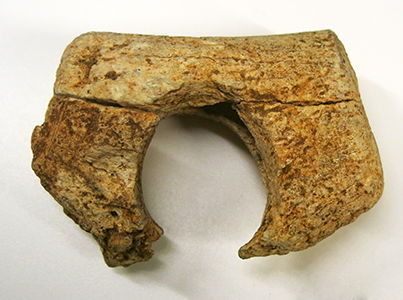
Fragment of an Aurignacian pierced baton from Laussel.
Material: Reindeer antler.
Photo: Don Hitchcock 2015
Catalog: 61.3.140
Source: Original, Musée d'Aquitaine à Bordeaux
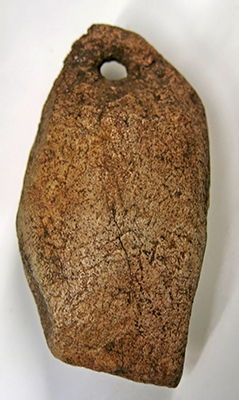
Aurignacian bone pendant from Laussel.
Photo: Don Hitchcock 2015
Catalog: 61.3.138
Source: Original, Musée d'Aquitaine à Bordeaux
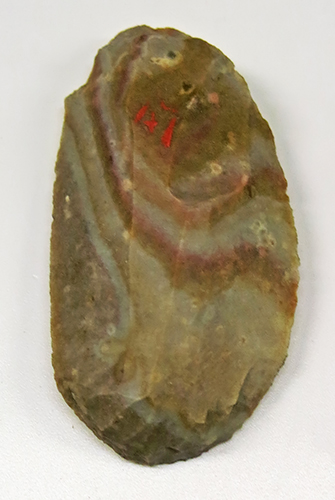
Grattoir, Grotte de Jolias, Prignac-et-Marcamps (33)
Flint, Inv. No. 60.913.1
Photo: Don Hitchcock 2015
Source: Original, Musée d'Aquitaine à Bordeaux
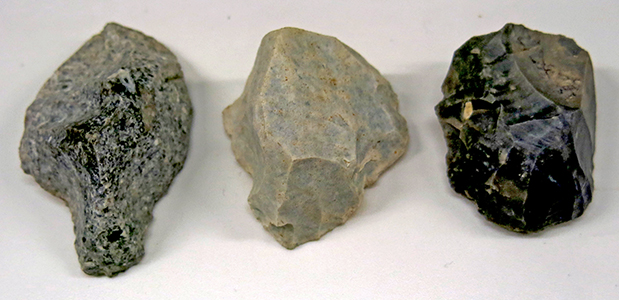
Grattoirs à museau, Grotte de Jolias, Prignac-et-Marcamps (33)
Flint, Inv. No. 60.913.5 (sic)
Photo: Don Hitchcock 2015
Source: Original, Musée d'Aquitaine à Bordeaux
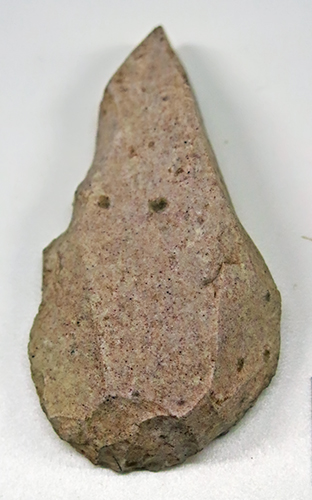
Grattoir - burin, Laussel, Marquay (24)
Flint, Inv. No. 60.3.87 (sic)
Photo: Don Hitchcock 2015
Source: Original, Musée d'Aquitaine à Bordeaux

Grattoir double sur Lame aurignacienne, double grattoir on an aurignacian blade, Abri de Cro Magnon, Les Eyzies-de-Tayac (24)
Flint, Inv. No. 60.419.1
Photo: Don Hitchcock 2015
Source: Original, Musée d'Aquitaine à Bordeaux

Grattoirs museaux, muzzle shaped scrapers.
Photo: Don Hitchcock 2014
Source: Original, Musée d’art et d’archéologie du Périgord, Périgueux
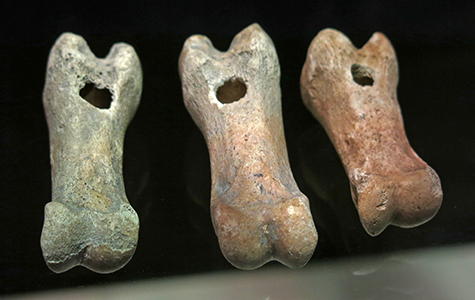
Whistles from la Grotte d'Aurignac.
Photo: Don Hitchcock 2014
Source: Original, Musée d’art et d’archéologie du Périgord, Périgueux

Split base spear points, characteristic of the Aurignacian.
Photo: Don Hitchcock 2014
Source: Original, Musée d’art et d’archéologie du Périgord, Périgueux
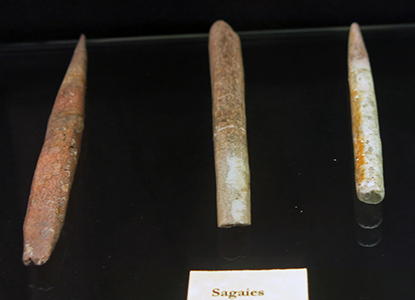
Spear points.
Photo: Don Hitchcock 2014
Source: Original, Musée d’art et d’archéologie du Périgord, Périgueux
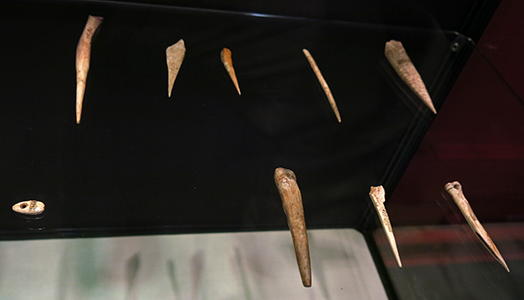
Bone awls, used for making holes in leather. The awl in the right foreground has an eye to secure it to a thong, to ensure that it doesn't get lost.
Photo: Don Hitchcock 2014
Source: Original, Musée d’art et d’archéologie du Périgord, Périgueux

Large retouched Aurignacian blade.
Photo: Don Hitchcock 2015
Source: Unknown provenance, original, Musée d'Archeologie Nationale et Domaine, St-Germain-en-Laye
L'abri Lartet
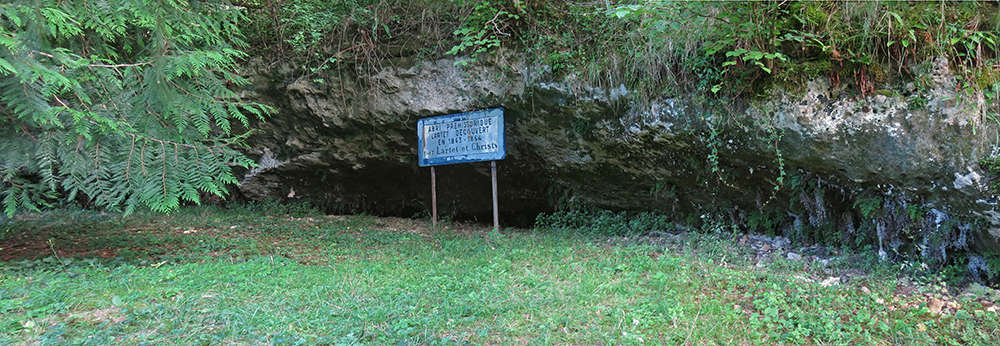
l'abri Lartet, Gorge d'Enfer, upstream twenty metres from l'abri du Poisson.
Photo: Don Hitchcock 2014
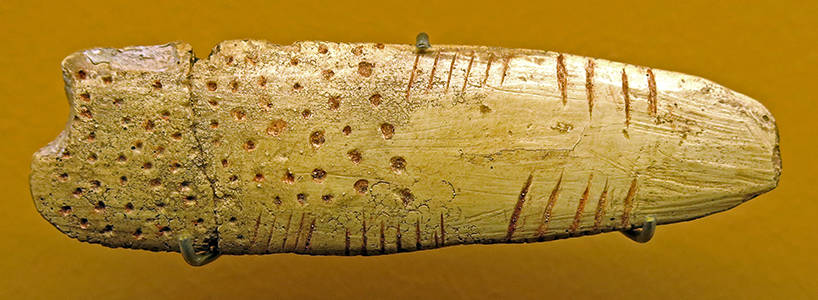
Aurignacian of l'abri Lartet aux Eyzies-de-Tayac, Dordogne
Os gravé et encoché (moulage), engraved and notched bone.
This was discovered in 1865.
Photo: Don Hitchcock 2014
Source: Facsimile, Musée d'Archeologie Nationale et Domaine, St-Germain-en-Laye
L'abri Castenet
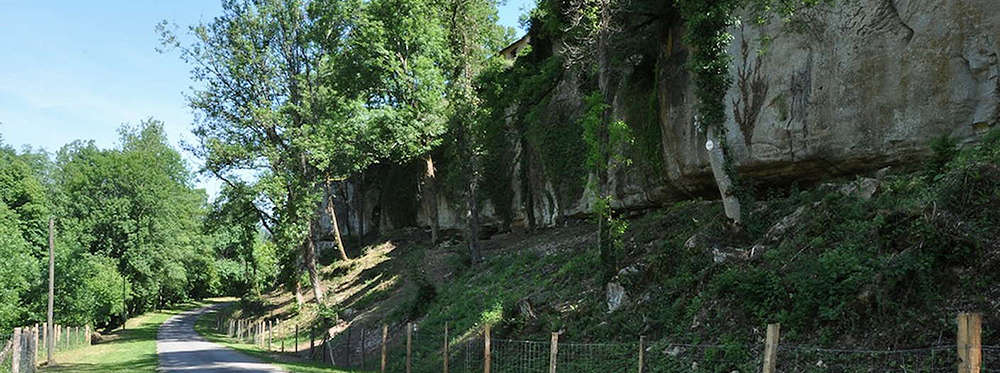
L'abri Castanet
Photo: http://www.livescience.com/20278-gallery-europe-oldest-rock-art.html
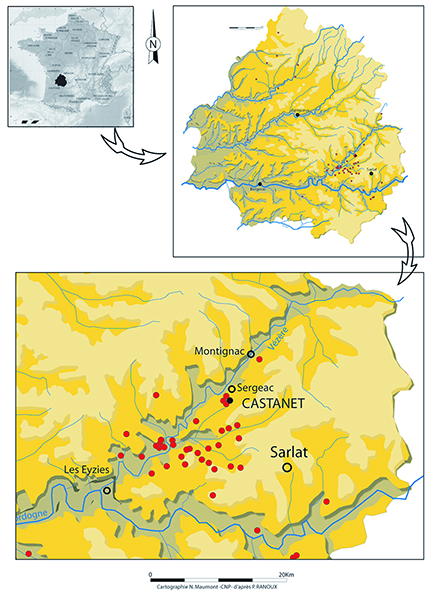
The geographical situation of l'abri Castanet in the Vallon des Roches.
Red dots: Principal Aurignacian sites of the valleys of the Vézère and the Dordogne.
Photo and text: Mensan et al. (2012)
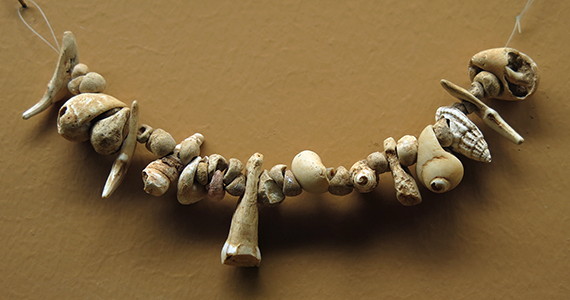
Aurignacian of l'abri Castanet.
Necklace of beads with teeth and shells.
Photo: Don Hitchcock 2015
Source: Original, Musée d'Archeologie Nationale et Domaine, St-Germain-en-Laye
Text: https://www.photo.rmn.fr
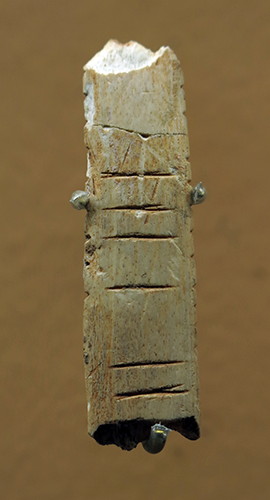
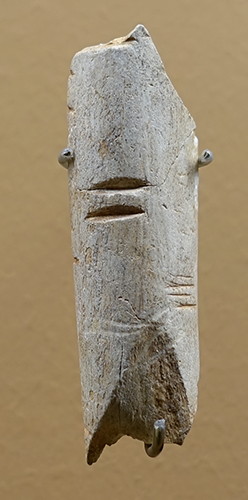
Aurignacian of l'abri Castanet.
Engraved bones.
Photo: Don Hitchcock 2015, 2018
Source: Original, Musée d'Archeologie Nationale et Domaine, St-Germain-en-Laye
Text: https://www.photo.rmn.fr


Aurignacian of l'abri Castanet.
Five split base spear points, typical of the Aurignacian.
Photo: Don Hitchcock 2015
Source: Original, Musée d'Archeologie Nationale et Domaine, St-Germain-en-Laye

Aurignacian of l'abri Castanet.
(left): Biseau.
( This is labelled as a biseau, or bevel. Possibly it was used in a similar manner to a ciseau, or wedge, in splitting antler and bone - Don )
(right): Lissoir.
( note that this lissoir has been modified in the manner of a very much smaller shouldered flint point to accept a shaft, or in this case, a handle - Don )
Photo: Don Hitchcock 2015
Source: Original, Musée d'Archeologie Nationale et Domaine, St-Germain-en-Laye
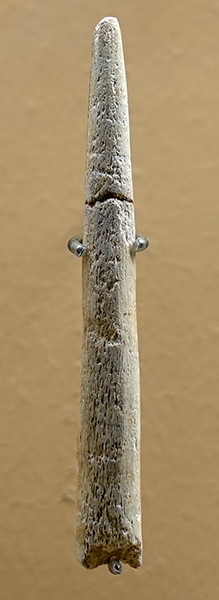


Aurignacian of l'abri Castanet.
(left and centre): Two spear points.
(right): Blade.
Photo: Don Hitchcock 2018, 2015
Source: Original, Musée d'Archeologie Nationale et Domaine, St-Germain-en-Laye
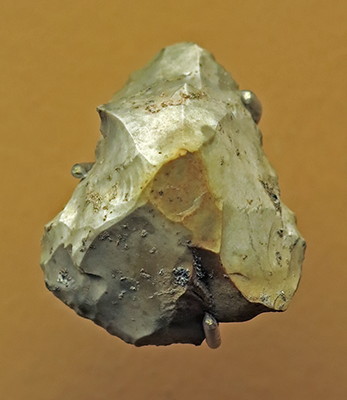
Aurignacian of l'abri Castanet.
Grattoir caréné - carinated scraper.
Photo: Don Hitchcock 2015
Source: Original, Musée d'Archeologie Nationale et Domaine, St-Germain-en-Laye
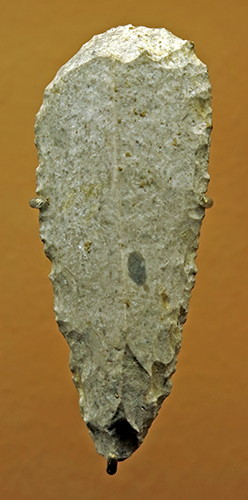
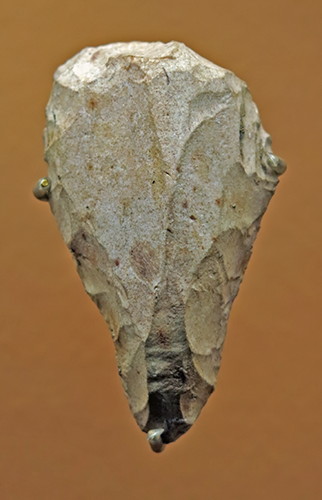
Aurignacian of l'abri Castanet.
Grattoirs - scrapers.
Photo: Don Hitchcock 2015
Source: Original, Musée d'Archeologie Nationale et Domaine, St-Germain-en-Laye
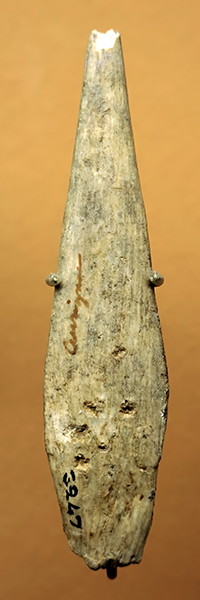

Aurignacian of l'abri Castanet.
(left): Split base spear point.
(right): Lissoir, used for working leather.
Photo: Don Hitchcock 2015
Source: Original, Musée d'Archeologie Nationale et Domaine, St-Germain-en-Laye

Aurignacian of l'abri Castanet.
Bone awl, used for making holes in leather.
Photo: Don Hitchcock 2015
Source: Original, Musée d'Archeologie Nationale et Domaine, St-Germain-en-Laye
Aurignacian of l'abri Castanet.
Engraved bone.
( This is in fact an idiophone, a musical instrument, played by running a stick along either side, as can be seen by the well worn notches on the top and bottom of this image, put there expressly for this purpose - Don )
Photo: Don Hitchcock 2018
Source: Original, Musée d'Archeologie Nationale et Domaine, St-Germain-en-Laye
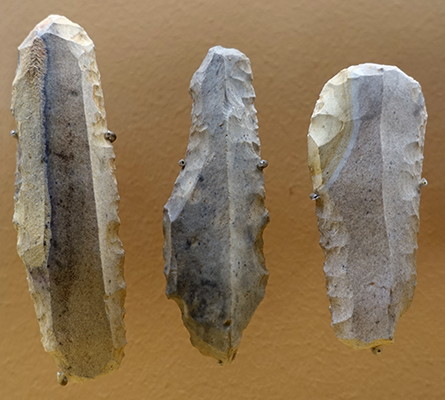
Aurignacian of l'abri Castanet.
Grattoirs, or scrapers, made on a blade.
Photo: Don Hitchcock 2018
Source: Original, Musée d'Archeologie Nationale et Domaine, St-Germain-en-Laye
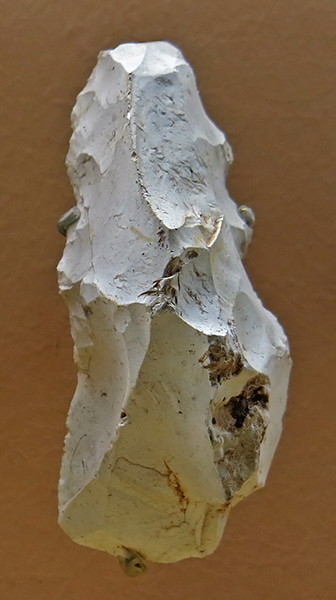
Aurignacian of l'abri Castanet.
Grattoir caréné, or carinated/keeled scraper.
Photo: Don Hitchcock 2014
Source: Original, Musée d'Archeologie Nationale et Domaine, St-Germain-en-Laye

Aurignacian of l'abri Castanet.
(left): Burin.
(right): Perçoir or Drill.
Photo: Don Hitchcock 2018
Source: Original, Musée d'Archeologie Nationale et Domaine, St-Germain-en-Laye
L'abri Blanchard des Roches

L'abri Blanchard des Roches
Photo: Don Hitchcock 2014
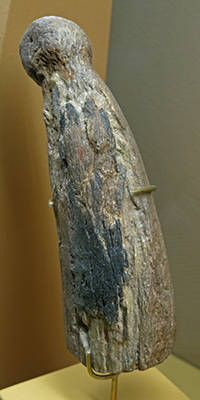
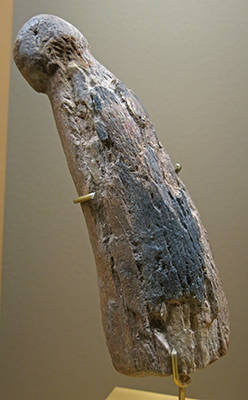
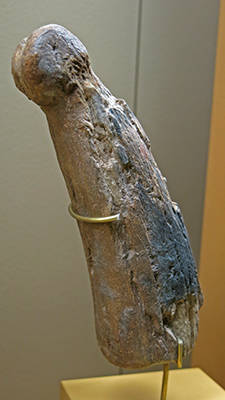
Aurignacian of l'abri Blanchard des Roches à Sergeac, Dordogne
Sculpture figurant un phallus, corne, sculpture of a phallus, horn.
Photo: Don Hitchcock 2014
Source: Original, Musée d'Archeologie Nationale et Domaine, St-Germain-en-Laye

Aurignacian of l'abri Blanchard des Roches à Sergeac, Dordogne
29: Bâton percé, spear straightener.
This object is in very good condition, and has a hole which is almost perfectly cylindrical, as though it has been drilled using a modern drill bit.
It has been distorted into an oval shape by use.
Photo: Don Hitchcock 2014
Source: Original, Musée d'Archeologie Nationale et Domaine, St-Germain-en-Laye
Aurignacian of l'abri Blanchard des Roches à Sergeac, Dordogne
Engraved and notched bone.
This is the famous 'calendar bone'.
Photo: Don Hitchcock 2015
Source: Facsimile, Musée d'Archeologie Nationale et Domaine, St-Germain-en-Laye

Aurignacian of l'abri Blanchard des Roches à Sergeac, Dordogne
Marshack’s schematic of the engraved marks on the Blanchard bone. Courtesy Harvard University, Peabody Museum.
Photo: Marshack, in http://www.cabinetmagazine.org/issues/28/rosenberg.php, rotated 180° to agree with the photo of the bone.

Aurignacian of l'abri Blanchard des Roches à Sergeac, Dordogne
Marshack’s schematic of the Blanchard bone marks laid out flat next to his own lunar schema for comparison.
Photo: Marshack, in http://www.cabinetmagazine.org/issues/28/rosenberg.php
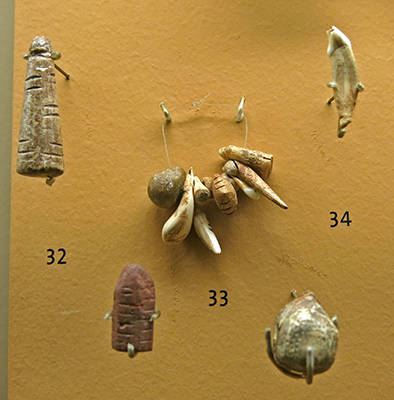
Aurignacian of l'abri Blanchard des Roches à Sergeac, Dordogne
32 and 34: Pendoloque, pendant.
33: Collier, necklace.
Bottom left: Object in haematite
Bottom right: Object in ivory (Facsimile)
Photo: Don Hitchcock 2014
Source: Original, Musée d'Archeologie Nationale et Domaine, St-Germain-en-Laye
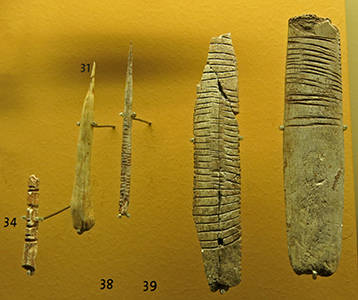
Aurignacian of l'abri Blanchard des Roches à Sergeac, Dordogne
Left: Os gravé, engraved bone.
38 and 39: Poinçon, awl.
Second from right: Bois gravé, engraved antler.
Far right: Ciseau gravé, engraved chisel or wedge.
Photo: Don Hitchcock 2014
Source: Original, Musée d'Archeologie Nationale et Domaine, St-Germain-en-Laye
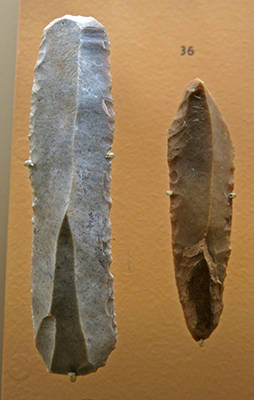
Aurignacian of l'abri Blanchard des Roches à Sergeac, Dordogne
Left: Lame retouchée, retouched blade.
Right: Burin.
Photo: Don Hitchcock 2014
Source: Original, Musée d'Archeologie Nationale et Domaine, St-Germain-en-Laye
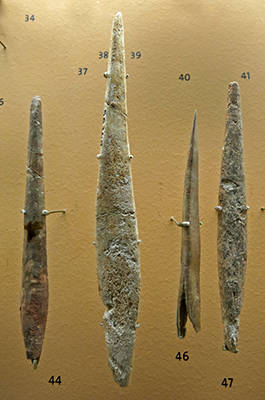
Aurignacian of l'abri Blanchard des Roches à Sergeac, Dordogne
Left and centre right: Sagaie à base fendue, spear point with split base.
Centre left and right: Sagaie losangique, rhombic spearpoint, also characteristic of the Aurignacian.
Photo: Don Hitchcock 2014
Source: Original, Musée d'Archeologie Nationale et Domaine, St-Germain-en-Laye
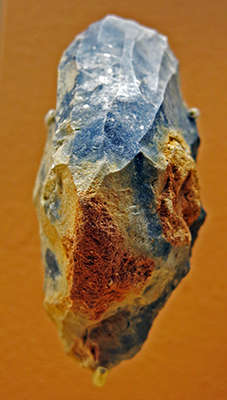
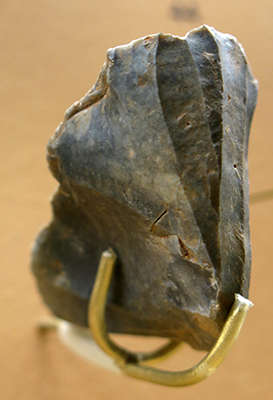
Aurignacian of l'abri Blanchard des Roches à Sergeac, Dordogne
Grattoir carénés, keeled scrapers.
Photo: Don Hitchcock 2014
Source: Original, Musée d'Archeologie Nationale et Domaine, St-Germain-en-Laye
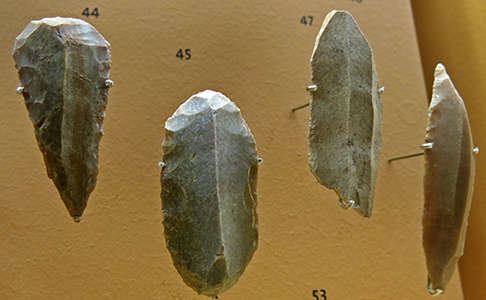
Aurignacian of l'abri Blanchard des Roches à Sergeac, Dordogne
Far left: Grattoir, scraper.
Centre left: Grattoir double, scraper on each end of the tool.
Centre right: Burin.
Far right: Perçoir, drill.
Photo: Don Hitchcock 2014
Source: Original, Musée d'Archeologie Nationale et Domaine, St-Germain-en-Laye

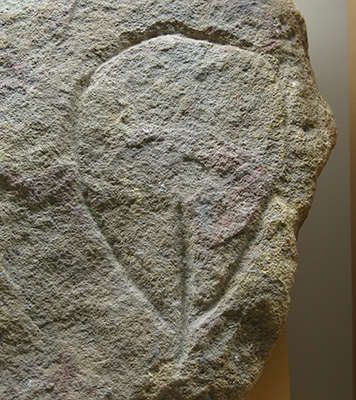
Aurignacian of l'abri Blanchard des Roches à Sergeac, Dordogne
Gravure figurant une vulve, calcaire. Engraving of a vulva, in limestone.
Photo: Don Hitchcock 2014
Source: Original, Musée d'Archeologie Nationale et Domaine, St-Germain-en-Laye
La Ferrassie
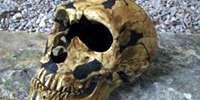 La Ferrassie is a very important site, and is treated in greater detail here.
La Ferrassie is a very important site, and is treated in greater detail here.


La Ferrassie
La Ferrassie is on the inside of a curve in the road at approximately 44.9514N, 0.9379E.
Photo: Don Hitchcock 2008

Aurignacian of l'abri de La Ferrassie en Dordogne, Couches H et F
Far left: Lame, blade. This piece is unusual for its 'bent' shape, curved from end to end.
Centre left, upper and lower: Grattoir caréné, keeled scraper.
Centre right: Grattoir double, scraper on each end of the tool.
Far right, upper and lower: Burin.
Photo: Don Hitchcock 2014
Source: Original, Musée d'Archeologie Nationale et Domaine, St-Germain-en-Laye

Aurignacian of l'abri de La Ferrassie en Dordogne, Couches H et F
Left to right:
perçoir, drill
poinçon, awl.
Biseau, wedge.
Sagaie losangique, Rhombic spearpoint, typical of the Aurignacian.
Sagaie à base fendue, spearpoint with split base.
Sagaie losangique, Rhombic spearpoint, typical of the Aurignacian.
Photo: Don Hitchcock 2014
Source: Original, Musée d'Archeologie Nationale et Domaine, St-Germain-en-Laye
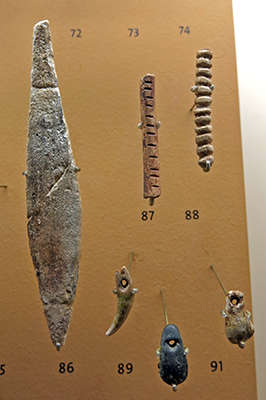
Aurignacian of l'abri de La Ferrassie en Dordogne, Couches H et F
86: Sagaie losangique, Rhombic spearpoint, typical of the Aurignacian.
87: Tube
88: objet en os, object made of bone.
89, 90, 91: Pendeloque, pendant.
Photo: Don Hitchcock 2014
Source: Original, Musée d'Archeologie Nationale et Domaine, St-Germain-en-Laye
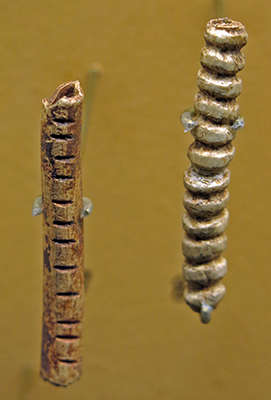
Aurignacian of l'abri de La Ferrassie en Dordogne, Couches H et F
Left: Tube
Right: objet en os, object made of bone.
Photo: Don Hitchcock 2014
Source: Original, Musée d'Archeologie Nationale et Domaine, St-Germain-en-Laye
La Gravette
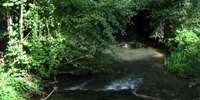
La Gravette, the type site for the Gravettian, is treated in greater detail here.
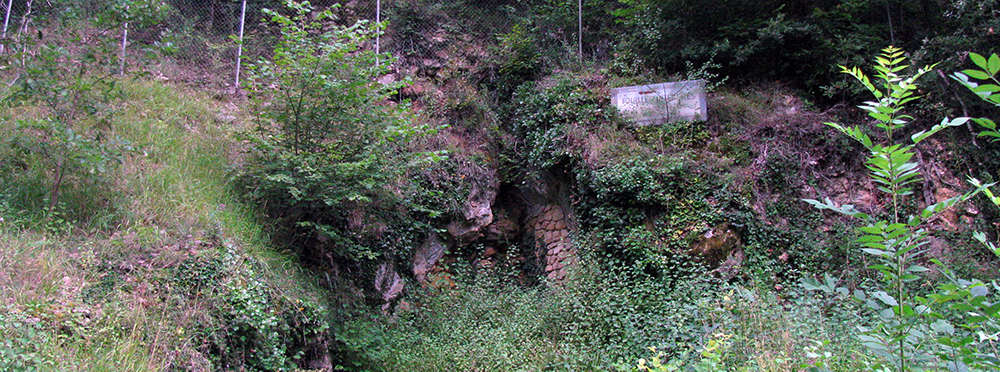
The gisement of La Gravette
Photo: Don Hitchcock 2008
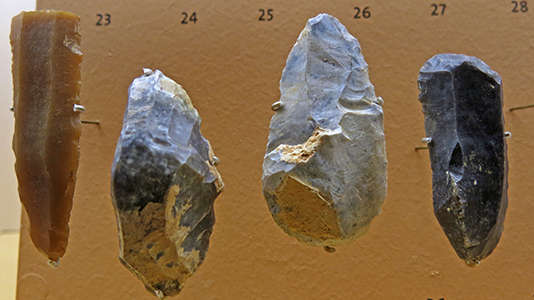
Aurignacien of l'abri de la Gravette à Bayac, Dordogne
Far left: Lame retouchée, retouched blade.
Centre left: Grattoir caréné, keeled scraper.
Centre right and far right: Grattoir, scraper.
Photo: Don Hitchcock 2014
Source: Original, Musée d'Archeologie Nationale et Domaine, St-Germain-en-Laye
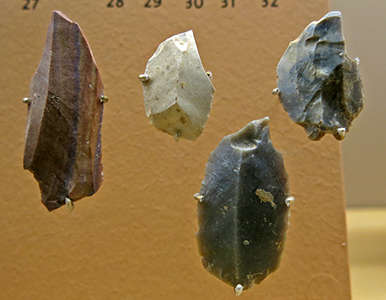
Aurignacien of l'abri de la Gravette à Bayac, Dordogne
Far left: Burin.
Other three artefacts: Burin busqué, beaked burin.
Photo: Don Hitchcock 2014
Source: Original, Musée d'Archeologie Nationale et Domaine, St-Germain-en-Laye
Aurignacien of la grotte du Chien à Péchialet, Dordogne
Gravure figurant deux hommes attaqués par un ours, schiste.
Engraving showing two men attacked by a bear (or, more likely, attacking a bear), on schist.
The schist plaque was imported from Alassac (Corrèze). Each man is about 8 cm high. The style of the figures is close to a similar plaque from Limeuil, found in a Magdalenian layer. Length of plaque 18.5 cm. Note that although this has been assigned to the Aurignacean on the basis of other materials found with it, it more closely resembles Magdalenian artefacts from other sites.
Powers (1994)
Photo: Don Hitchcock 2014
Source: Original, Musée d'Archeologie Nationale et Domaine, St-Germain-en-Laye
The Aurignacian of Bockova Dira Höhle, Mladeč/Lautsch, in the Czech Republic
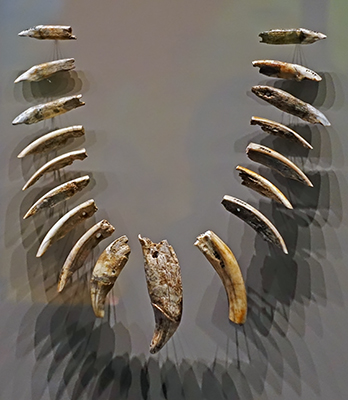
Necklaces were made from drilled animal teeth, suspended on a cord. These are from wild horse, elk, beaver and reindeer, 36 000 - 34 000 BP.
( However the lowest tooth and the one to the left of it look very much like cave bear teeth - Don )
Photo: Don Hitchcock 2018
Source: Museum of Natural History, Vienna

Bone and ivory were used for projectile points.
This is a Mladeč point.
Photo: Don Hitchcock 2018
Source: Museum of Natural History, Vienna
The late Aurignacian of Nová Dědina, in the Czech Republic
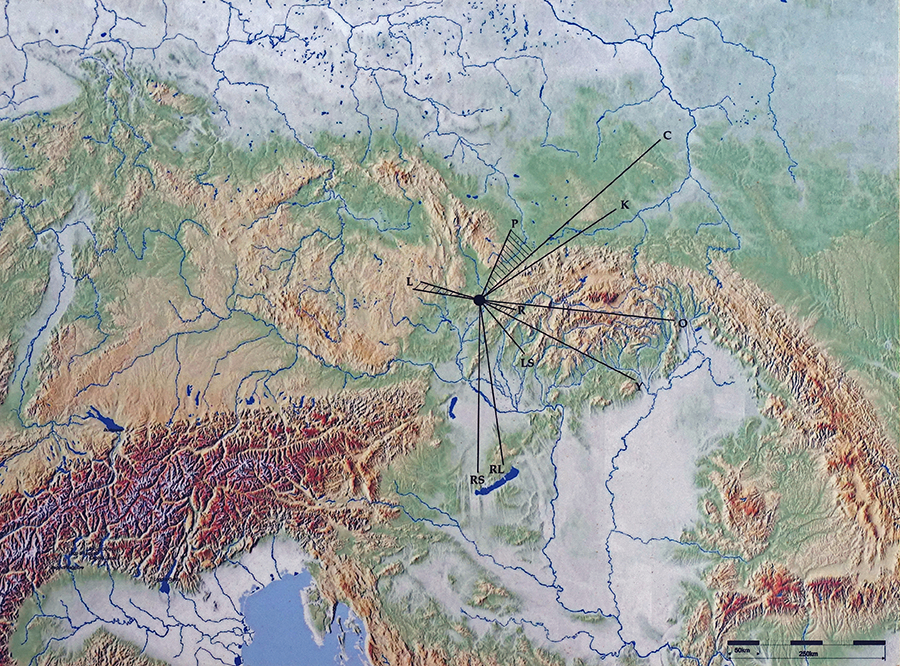
Legend: P flint, R radiolarite, L rock crystal, LS limnosilicates, specularite, Y rhyolite, O obsidian, RS radiolarite subtype Sümeg, RL radiolarite subtype Szentgál, K Jurassic podkrakovský flint, C 'chocolate' flint.
This map shows a hypothetical Late Aurignacian site on the Morava river, at which the sources for tools were mostly imported raw materials. However the most varied spectrum of imported stone was utilised at the rich station of Nová Dědina, 50 km west of Brno.
The tools below are from Nová Dědina but were unidentified as to use. I have attempted to identify the tools where I can - Don
Rephotography: Don Hitchcock 2018
Source: Display, Anthropos Pavilion/Moravian Museum, Brno, Czech Republic
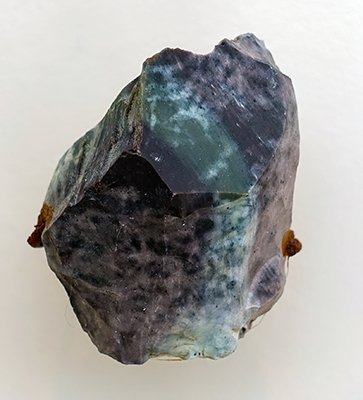
This is a typically shaped core of the Aurignacian, from which many blades have been struck.
Photo and text: Don Hitchcock 2018
Source: Original, Anthropos Pavilion/Moravian Museum, Brno, Czech Republic
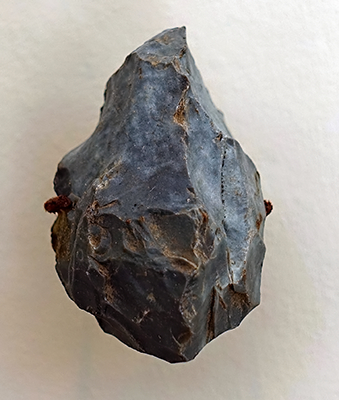
The burin was invented by the Aurignacians, and made fine engravings and small sculptures of ivory and stone possible. This type is generally known as a Burin Busqué, or beaked burin, and here is made on a flake.
Photo and text: Don Hitchcock 2018
Source: Original, Anthropos Pavilion/Moravian Museum, Brno, Czech Republic
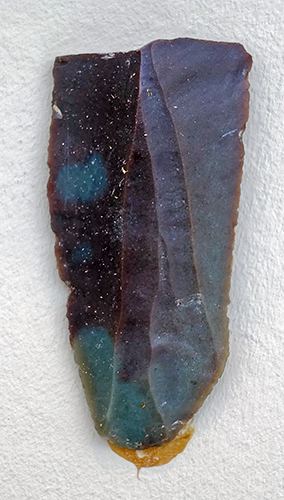
This well made blade, shown here broken in half, has been very finely retouched by pressure flaking, to restore sharpness for use as a knife.
Photo and text: Don Hitchcock 2018
Source: Original, Anthropos Pavilion/Moravian Museum, Brno, Czech Republic
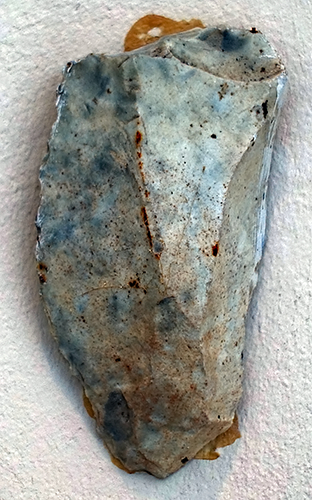
This (now broken) blade has been made into a backed knife, one of the most common blade tools of the Upper Palaeolithic.
One side of the blade has been steeply retouched by pressure flaking, to allow it to be held in the hand, with the index finger on the dulled side, in order to cut with the opposite sharp edge. They were about as good as a steel knife for skinning an animal, though of course they had many other uses.
Photo and text: Don Hitchcock 2018
Source: Original, Anthropos Pavilion/Moravian Museum, Brno, Czech Republic
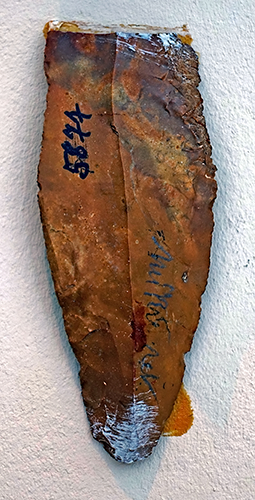
This beautifully made blade has been reshaped and steeply retouched at the upper end, possibly to accept a leather or wooden handle.
The rest of the knife has been finely pressure flaked along its length to resharpen it.
Photo and text: Don Hitchcock 2018
Source: Original, Anthropos Pavilion/Moravian Museum, Brno, Czech Republic
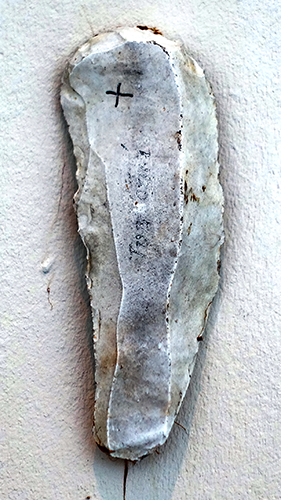
The invention of blade technology, where many long, thin, and sharply edged blades could be struck quickly and easily from a prepared core created a huge increase in the range of tools which could be made. This grattoir, or end scraper, is a case in point. The sides have been steeply retouched to blunt them, so that it could be held in the hand.
Photo and text: Don Hitchcock 2018
Source: Original, Anthropos Pavilion/Moravian Museum, Brno, Czech Republic
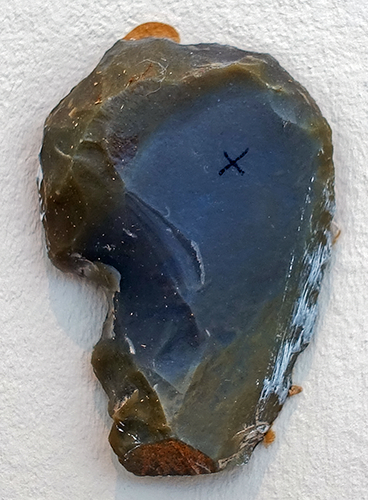
This scraper has been made on a flake, and has been turned into a notched scraper in order to smooth spear shafts as well as normal side and nosed scraper usage.
Photo and text: Don Hitchcock 2018
Source: Original, Anthropos Pavilion/Moravian Museum, Brno, Czech Republic

This nosed scraper has been made on a thick flake.
Photo and text: Don Hitchcock 2018
Source: Original, Anthropos Pavilion/Moravian Museum, Brno, Czech Republic
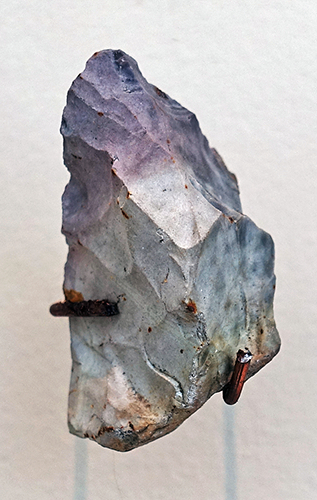
This 'high' scraper, or grattoir carené, appears to have been made from a recycled core, which otherwise would have been discarded.
Photo and text: Don Hitchcock 2018
Source: Original, Anthropos Pavilion/Moravian Museum, Brno, Czech Republic
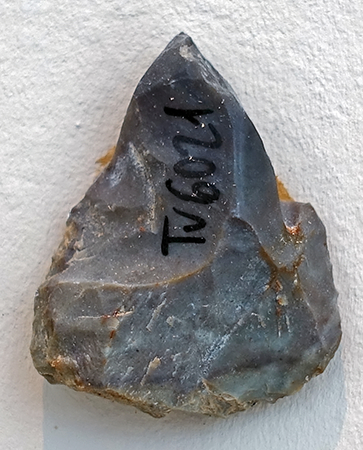
This burin might best be described as a carinate or keeled burin, but it has similarities to the Paviland burin of the late Aurignacian.
Photo and text: Don Hitchcock 2018
Source: Original, Anthropos Pavilion/Moravian Museum, Brno, Czech Republic
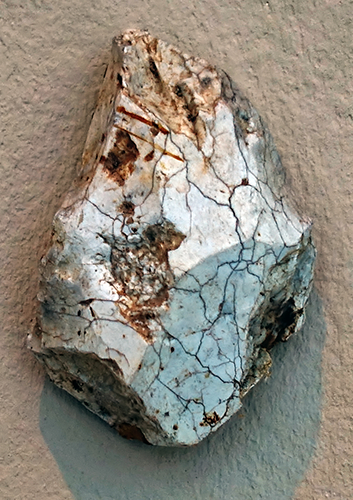
A beaked burin in desperate need of resharpening.
Photo and text: Don Hitchcock 2018
Source: Original, Anthropos Pavilion/Moravian Museum, Brno, Czech Republic
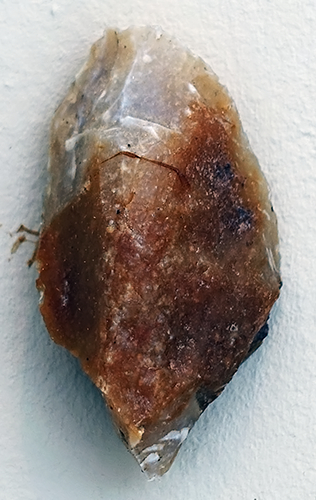
A carinate or keeled tool, with a scraper on one end and a burin on the other.
Photo and text: Don Hitchcock 2018
Source: Original, Anthropos Pavilion/Moravian Museum, Brno, Czech Republic
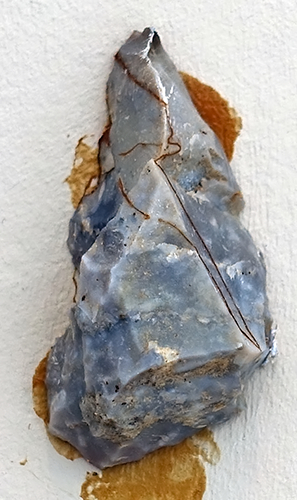
Burin on a truncation.
Photo and text: Don Hitchcock 2018
Source: Original, Anthropos Pavilion/Moravian Museum, Brno, Czech Republic
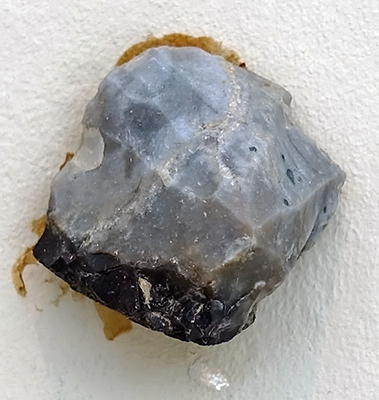
A very small 'high' keeled scraper, or grattoir carené.
Photo and text: Don Hitchcock 2018
Source: Original, Anthropos Pavilion/Moravian Museum, Brno, Czech Republic
References
- Armand, D., 2006: Abri castanet (Dordogne, France): An Aurignacian site with bear procurement. Bear exploitation in paleolithic time. Scientific Annals, School of Geology Aristotle University of Thessaloniki (AUTH) Special volume 98 263-268 Thessaloniki, 2006
- Bahn, P.G., 2007: Cave Art: A Guide to the Decorated Ice Age Caves of Europe Published by Frances Lincoln ltd, 2007 ISBN 0711226555, 9780711226555 224 pages
- Castanet, R., 2006: Les Perles de Sergeac en Périgord Noir Grapho 12 Imprimeur, 12200 Villefranche-de-Rouergue, ISBN 2 9510260 1-3
- Delage, F., 1927: Sergeac : un beau site périgourdin, un centre de recherches préhistoriques, Imp. de la Vézère, 22 p. ill.
- Delage, F., 1935: Les Roches de Sergeac (Dordogne), L'Anthropologie,45, pp. 281-317, 21 fig.
- Delage, F., 1936: Livres et Revues Bull. S.P.F., T. XXXIII (1): 87 - 96
- Delluc B. & Delluc G., 1978: Les manifestations graphiques aurignaciennes sur support rocheux des environs des Eyzies (Dordogne), Gallia Préhistoire , Tome 21 fascicule 2, 1978. pp. 333-438.
- Delluc B. & Delluc G., 1981: Les manifestations graphiques aurignaciennes sur support rocheux des environs des Eyzies (Dordogne), Gallia Préhistoire , 21, 213–438.
- Didon L., 1911: L’Abri Blanchard des Roches (commune de Sergeac). Gisement aurignacien moyen, Bulletin de la Société Historique et Archéologique du Périgord, 87, 246–61 & 321–45.
- Didon L., 1912: Faits nouveaux constatés dans une station aurignacienne, L’Abri Blanchard des Roches prés de Sergeac, L'Anthropologie , 23, 603.
- Leroy-Prost, C., 1975: L'industrie osseuse aurignacienne. Essai régional de classification: Poitou, Charentes, PérigordGallia préhistoire Tome 18 fascicule 1, 1975. pp. 65-156.
- MacCurdy, G.G., 1931: Anthropology: Vol. 17, 1931 pp 633-637
- Mellars, P., 1996: The Neanderthal legacy: an archaeological perspective from western Europe Published by Princeton University Press ISBN 0691034931, 9780691034935 471 pages
- Mensan R., Bourrillon R., Cretin C., White R., Gardère P., Chiotti L., Sisk M., Clark A., Higham T., Tartar É., 2012: Une nouvelle découverte d’art pariétal aurignacien in situ à l’abri Castanet (Dordogne, France): contexte et datation, Paléo 23 (2012) Varia
- Peyrony, D., 1935: Le gisement de Castanet, Vallon de Castelmerle, commune de Sergeac (Dordogne). Aurignacien I et II.- Bull. S.P.F., T. XXXII (19): 418-443.
- Powers, R., 1994: The Human Form in Palaeolithic ArtModern Geology,, (Ed.), T. 19(2-4), 1-34
- White R., 1989: Production complexity and standardisation in early Aurignacian bead and pendant manufacture: Evolutionary implications, in The Human Revolution: Behavioural and Biological Perspectives on the Origins of Modern Humans eds. C. Stringer & P. Mellars. Edinburgh: Edinburgh University Press, 366–90.
- White R., 2007: Systems of Personal Ornamentation in the Early Upper Palaeolithic: Methodological Challenges and New Observations. In, Mellars, Paul, Boyle, Katie, Bar-Yosef, Ofer and Stringer, Chris (eds.) Rethinking the Human Revolution: New Behavioural and Biological Perspectives on the Origin and Dispersal of Modern Humans. Cambridge, UK, McDonald Institute for Archaeological Research, 287-302. (McDonald Institute Monographs).
- White R., Mensan R., Bourillon R., Cretin C., Higham T., Clark A., Sisk M., Tartar E., Gardere P., Goldberg P., Pelegrin J., Valladas H., Tisnerat-Laborde N., de Sanoit J., Chambellan D., Chiotti L., 2012: Context and dating of Aurignacian vulvar representations from Abri Castanet, France, PNAS May 29, 2012, vol. 109, no. 22
Back to Don's Maps
 Back to Archaeological Sites
Back to Archaeological Sites
